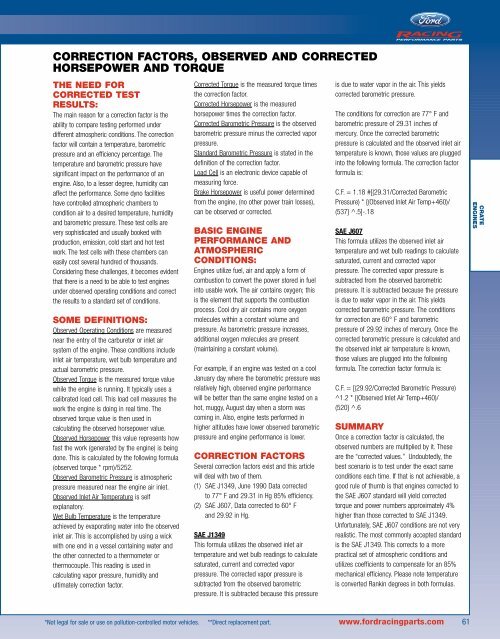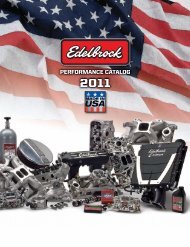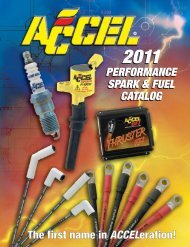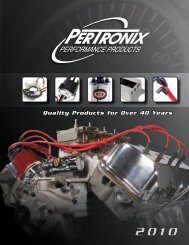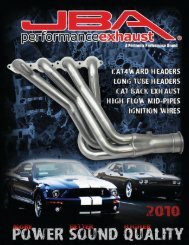2006 Ford Racing Performance Parts Catalog - Chromwerk
2006 Ford Racing Performance Parts Catalog - Chromwerk
2006 Ford Racing Performance Parts Catalog - Chromwerk
Create successful ePaper yourself
Turn your PDF publications into a flip-book with our unique Google optimized e-Paper software.
CORRECTION FACTORS, OBSERVED AND CORRECTED<br />
HORSEPOWER AND TORQUE<br />
THE NEED FOR<br />
CORRECTED TEST<br />
RESULTS:<br />
The main reason for a correction factor is the<br />
ability to compare testing performed under<br />
different atmospheric conditions. The correction<br />
factor will contain a temperature, barometric<br />
pressure and an efficiency percentage. The<br />
temperature and barometric pressure have<br />
significant impact on the performance of an<br />
engine. Also, to a lesser degree, humidity can<br />
affect the performance. Some dyno facilities<br />
have controlled atmospheric chambers to<br />
condition air to a desired temperature, humidity<br />
and barometric pressure. These test cells are<br />
very sophisticated and usually booked with<br />
production, emission, cold start and hot test<br />
work. The test cells with these chambers can<br />
easily cost several hundred of thousands.<br />
Considering these challenges, it becomes evident<br />
that there is a need to be able to test engines<br />
under observed operating conditions and correct<br />
the results to a standard set of conditions.<br />
SOME DEFINITIONS:<br />
Observed Operating Conditions are measured<br />
near the entry of the carburetor or inlet air<br />
system of the engine. These conditions include<br />
inlet air temperature, wet bulb temperature and<br />
actual barometric pressure.<br />
Observed Torque is the measured torque value<br />
while the engine is running. It typically uses a<br />
calibrated load cell. This load cell measures the<br />
work the engine is doing in real time. The<br />
observed torque value is then used in<br />
calculating the observed horsepower value.<br />
Observed Horsepower this value represents how<br />
fast the work (generated by the engine) is being<br />
done. This is calculated by the following formula<br />
(observed torque * rpm)/5252.<br />
Observed Barometric Pressure is atmospheric<br />
pressure measured near the engine air inlet.<br />
Observed Inlet Air Temperature is self<br />
explanatory.<br />
Wet Bulb Temperature is the temperature<br />
achieved by evaporating water into the observed<br />
inlet air. This is accomplished by using a wick<br />
with one end in a vessel containing water and<br />
the other connected to a thermometer or<br />
thermocouple. This reading is used in<br />
calculating vapor pressure, humidity and<br />
ultimately correction factor.<br />
Corrected Torque is the measured torque times<br />
the correction factor.<br />
Corrected Horsepower is the measured<br />
horsepower times the correction factor.<br />
Corrected Barometric Pressure is the observed<br />
barometric pressure minus the corrected vapor<br />
pressure.<br />
Standard Barometric Pressure is stated in the<br />
definition of the correction factor.<br />
Load Cell is an electronic device capable of<br />
measuring force.<br />
Brake Horsepower is useful power determined<br />
from the engine, (no other power train losses),<br />
can be observed or corrected.<br />
BASIC ENGINE<br />
PERFORMANCE AND<br />
ATMOSPHERIC<br />
CONDITIONS:<br />
Engines utilize fuel, air and apply a form of<br />
combustion to convert the power stored in fuel<br />
into usable work. The air contains oxygen; this<br />
is the element that supports the combustion<br />
process. Cool dry air contains more oxygen<br />
molecules within a constant volume and<br />
pressure. As barometric pressure increases,<br />
additional oxygen molecules are present<br />
(maintaining a constant volume).<br />
For example, if an engine was tested on a cool<br />
January day where the barometric pressure was<br />
relatively high, observed engine performance<br />
will be better than the same engine tested on a<br />
hot, muggy, August day when a storm was<br />
coming in. Also, engine tests performed in<br />
higher altitudes have lower observed barometric<br />
pressure and engine performance is lower.<br />
CORRECTION FACTORS<br />
Several correction factors exist and this article<br />
will deal with two of them.<br />
(1) SAE J1349, June 1990 Data corrected<br />
to 77° F and 29.31 in Hg 85% efficiency.<br />
(2) SAE J607, Data corrected to 60° F<br />
and 29.92 in Hg.<br />
SAE J1349<br />
This formula utilizes the observed inlet air<br />
temperature and wet bulb readings to calculate<br />
saturated, current and corrected vapor<br />
pressure. The corrected vapor pressure is<br />
subtracted from the observed barometric<br />
pressure. It is subtracted because this pressure<br />
*Not legal for sale or use on pollution-controlled motor vehicles. **Direct replacement part.<br />
is due to water vapor in the air. This yields<br />
corrected barometric pressure.<br />
The conditions for correction are 77° F and<br />
barometric pressure of 29.31 inches of<br />
mercury. Once the corrected barometric<br />
pressure is calculated and the observed inlet air<br />
temperature is known, those values are plugged<br />
into the following formula. The correction factor<br />
formula is:<br />
C.F. = 1.18 #[(29.31/Corrected Barometric<br />
Pressure) * {(Observed Inlet Air Temp+460)/<br />
(537} ^.5]-.18<br />
SAE J607<br />
This formula utilizes the observed inlet air<br />
temperature and wet bulb readings to calculate<br />
saturated, current and corrected vapor<br />
pressure. The corrected vapor pressure is<br />
subtracted from the observed barometric<br />
pressure. It is subtracted because the pressure<br />
is due to water vapor in the air. This yields<br />
corrected barometric pressure. The conditions<br />
for correction are 60° F and barometric<br />
pressure of 29.92 inches of mercury. Once the<br />
corrected barometric pressure is calculated and<br />
the observed inlet air temperature is known,<br />
those values are plugged into the following<br />
formula. The correction factor formula is:<br />
C.F. = [(29.92/Corrected Barometric Pressure)<br />
^1.2 * {(Observed Inlet Air Temp+460)/<br />
(520} ^.6<br />
SUMMARY<br />
Once a correction factor is calculated, the<br />
observed numbers are multiplied by it. These<br />
are the “corrected values.” Undoubtedly, the<br />
best scenario is to test under the exact same<br />
conditions each time. If that is not achievable, a<br />
good rule of thumb is that engines corrected to<br />
the SAE J607 standard will yield corrected<br />
torque and power numbers approximately 4%<br />
higher than those corrected to SAE J1349.<br />
Unfortunately, SAE J607 conditions are not very<br />
realistic. The most commonly accepted standard<br />
is the SAE J1349. This corrects to a more<br />
practical set of atmospheric conditions and<br />
utilizes coefficients to compensate for an 85%<br />
mechanical efficiency. Please note temperature<br />
is converted Rankin degrees in both formulas.<br />
www.fordracingparts.com 61<br />
CRATE<br />
ENGINES


